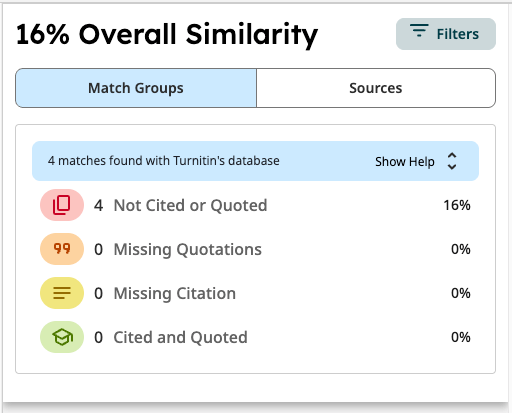How to Read and Revise Based on a Turnitin Similarity Report
Turnitin is a powerful tool for checking plagiarism, but understanding its report can be tricky for first-time users.
In this post, we’ll walk you through a typical Turnitin similarity report and show you how to interpret it effectively. By the end, you’ll know exactly how to revise your work to improve originality.
Overall Similarity Index

The second page of the Turnitin similarity report provides the Overall Similarity Index, which is the percentage of your document that matches other sources. Below this, you’ll find the filtering parameters used for the check.
For example, in this case, the option to “Exclude Bibliography” was selected. At the bottom of the page, there’s a summary of the matched content.
Sources of Similarity

The third page of the report lists all the sources of similarity. Each source is assigned a unique number, which corresponds to the highlighted sections in your document.
The top part of this page may repeat information from page 2, so you can focus on the lower section for detailed source information.
Highlighted Matches in Your Document

This section displays your original text with highlighted matches. Each highlighted section corresponds to a source listed in page 2. The highlights are accompanied by icons or numbers (sometimes just numbers), which make it easy to trace the source of each match.
Understanding Highlight Colors

Turnitin uses four main types of highlights to indicate different kinds of matches. Each type is represented by a specific color, as shown in the figure above. Here’s what they mean and how to address them:
Not Cited or Quoted
Meaning: The text matches another source but lacks both quotation marks and a citation. This indicates direct copying without any attribution.
Risk: High risk. This is often considered plagiarism.
How to Fix:
- Thoroughly paraphrase the content and provide proper attribution.
- If you need to retain the original text, add quotation marks and include a citation (e.g., “…” (Smith, 2020)).
Missing Quotations
Meaning: The text includes a citation (e.g., author and year) but lacks quotation marks, even though the content is nearly identical to the source.
Risk: Medium risk. This may result in penalties for failing to indicate a direct quote.
How to Fix:
- Add quotation marks around the exact text (e.g., “…”).
- Alternatively, rewrite the content to make it a paraphrase and retain the citation.
Missing Citations
Meaning: The text includes quotation marks but lacks a proper citation (e.g., no author, year, or reference entry).
Risk: High risk. This may be flagged as incomplete citation.
How to Fix:
- Add a complete citation (e.g., “…” (Smith, 2020, p.5)).
- Ensure the source is included in the reference list.
Cited and Quoted
Meaning: The text includes both quotation marks and a citation, but it is still flagged as a match. This could be due to improper citation formatting or excessive reliance on direct quotes.
Risk: Low risk. However, it’s worth reviewing for citation accuracy.
How to Fix:
- Verify that the quoted text matches the original source exactly.
- Ensure the citation format complies with the required style guide (e.g., APA, MLA).
- Avoid overusing direct quotes; instead, aim for paraphrasing or original analysis.
Final Tips
- Focus on revising the sections with the darkest highlights first, as these indicate the most critical issues.
- Use the source list to understand where the matches are coming from and rewrite the content in your own words.
- Always double-check the filtering parameters to ensure they align with your institution’s requirements.
By following these steps, you’ll be able to read and revise your Turnitin report like a pro. Happy writing!